
Bogus issue for Magdalena.
Return To Catalogue - Colombia overview
Note: on my website many of the
pictures can not be seen! They are of course present in the cd's;
contact me if you want to purchase them: evert@klaseboer.com.
Colombia consisted of: Antioquia, Bolivar, Boyaca, Cauca, Cundinamarca, Magdalena, Santander, Tolima. Every province, except Cauca and Magdalena issued its own stamps. The city of Bogota issued stamps as well.

Bogus issue for Magdalena.
Go to Antioquia

I've been told that these four stamps are genuine
0.01 black on yellow, lilac, blue, red or orange 0.02 black on yellow, lilac, blue, red or orange 0.05 black on yellow, lilac, blue, red or orange 0.10 black on yellow, lilac, blue, red or orange 0.20 black on yellow, lilac, blue, red or orange 0.40 black on blue 0.50 black on yellow, lilac, blue, red or orange 0.60 black on red 1.00 black on yellow, lilac, blue, red or orange 1.10 black on red 1.20 black on yellow, lilac, blue, red or orange 5.00 black on yellow, lilac, blue, red or orange
Value of the stamps |
|||
vc = very common c = common * = not so common ** = uncommon |
*** = very uncommon R = rare RR = very rare RRR = extremely rare |
||
| Value | Unused | Used | Remarks |
| All values | RR | RR | |
These stamps are very rare, beware of forgeries! The next stamps are probably forgeries:

This stamp with inscription 'Gobierno Provisional, CORREOS E.U.
de Colombia, Ejercito Restaurador. Barbacoas' is probably bogus.
It only appeared on the market in 1907. The values 1 c black on
blue, 2 c black on yellow, 5 c black on red, 10 c black on green
and 20 c black on brown exist.
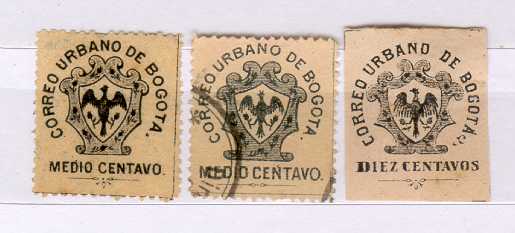
1/2 c black (2 types) 10 c black on pink (1910)
The 1/2 c is perforated 12. The 10 c is usually imperforate (also exist perforated: RR).
Value of the stamps |
|||
vc = very common c = common * = not so common ** = uncommon |
*** = very uncommon R = rare RR = very rare RRR = extremely rare |
||
| Value | Unused | Used | Remarks |
| 1/2 c | c | * | Both types |
| 10 c | *** | *** | |

5 c green
This stamp has perforation 13 1/2.
Value of the stamps |
|||
vc = very common c = common * = not so common ** = uncommon |
*** = very uncommon R = rare RR = very rare RRR = extremely rare |
||
| Value | Unused | Used | Remarks |
| 5 c | *** | ** | |


(Reduced sizes)
10 c grey 10 c blue 10 c orange (1904) 20 c brown (eagle) 50 c green 50 c grey 1 P red 1 P brown 5 P black on red (Bolivar statue) 10 P black on brown (president Roquin)
Most of these stamps exist perforated 12 or imperforate (except the 10 c blue, which is imperforate).
Value of the stamps |
|||
vc = very common c = common * = not so common ** = uncommon |
*** = very uncommon R = rare RR = very rare RRR = extremely rare |
||
| Value | Unused | Used | Remarks |
| 10 c grey | * | * | |
| 10 c blue | R | R | |
| 10 c orange | ** | ** | |
| 20 c | * | * | |
| 50 c blue | *** | *** | Imperforate: RR |
| 50 c green | ** | ** | Imperforate: R |
| 1 P red | ** | ** | Imperforate: *** |
| 1 P brown | *** | *** | |
| 5 P | *** | ** | |
| 10 P | *** | *** | Exists tete-beche: RR |
Some errors seem to exist (printed on the wrong background colour) and a 5 P with the '5' omitted.
Examples:

Reduced sizes
In this design I have seen the values: 5 c black, 10 c brown, 50 c blue, 1 P green, 5 P orange and 20 P brown.

5 c black 10 c black 20 c black 50 c black 1 P black 'UN PESO' black
These stamps were printed in sheets of five (as shown above). There were four different printings (with wrong spelling 'hai' or correct spelling 'hay').
Value of the stamps |
|||
vc = very common c = common * = not so common ** = uncommon |
*** = very uncommon R = rare RR = very rare RRR = extremely rare |
||
| Value | Unused | Used | Remarks |
| All values | RR | RR | |
10 c black
Value of the stamps |
|||
vc = very common c = common * = not so common ** = uncommon |
*** = very uncommon R = rare RR = very rare RRR = extremely rare |
||
| Value | Unused | Used | Remarks |
| 10 c | RRR | RRR | |

This stamp has a different text 'CTVS.' instead of 'CENTAVOS'.
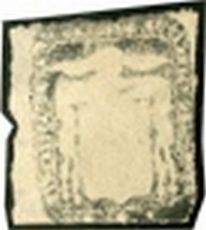
5 c black
Value of the stamps |
|||
vc = very common c = common * = not so common ** = uncommon |
*** = very uncommon R = rare RR = very rare RRR = extremely rare |
||
| Value | Unused | Used | Remarks |
| 5 c | RRR | RRR | |


Two letters with this Cauca stamp (both ex-Ferrary).
5 c violet (with numbers in corners) 5 c violet (without numbers)
Value of the stamps |
|||
vc = very common c = common * = not so common ** = uncommon |
*** = very uncommon R = rare RR = very rare RRR = extremely rare |
||
| Value | Unused | Used | Remarks |
| 5 c | RRR | RRR | With numbers |
| 5 c | RR | RR | Without numbers |

What is this? 5 c black on violet. Offered on a Behr auction in
2008.
5 c red
Value of the stamps |
|||
vc = very common c = common * = not so common ** = uncommon |
*** = very uncommon R = rare RR = very rare RRR = extremely rare |
||
| Value | Unused | Used | Remarks |
| 5 c | RR | RR | |
10 c black on red 20 c black on orange
Value of the stamps |
|||
vc = very common c = common * = not so common ** = uncommon |
*** = very uncommon R = rare RR = very rare RRR = extremely rare |
||
| Value | Unused | Used | Remarks |
| 10 c | *** | *** | Two types, second type: R |
| 20 c | *** | *** | |
Bogus issue for Cauca:
Eagle, the inscription reads 'REPUBLICA DE COLOMBIA CORREOS PROVINCIA DE CAUCA'. It seems to have been issued in 1892. I have seen: 5 c red and 10 c green. Pictures can also be found in 'The Fournier album of Philatelic Forgeries' by Ragatz, though in Fourniers1914 pricelist, Fournier does not mention these stamps.
Click here for stamps of Cundinamarca.

(Reduced size)
$0,01 black $0,01 black (with extra inscription 'Junio de 1894' UN PESO black
These stamps are printed on paper taken from school books.
Value of the stamps |
|||
vc = very common c = common * = not so common ** = uncommon |
*** = very uncommon R = rare RR = very rare RRR = extremely rare |
||
| Value | Unused | Used | Remarks |
| 1 c black | RR | RR | |
| 1 c black (Junio de 1894) | RR | R | |
| 1 P | RR | R | |


What are these? Similar labels, but with different inscription.

0,01 on 2 c green
Value of the stamps |
|||
vc = very common c = common * = not so common ** = uncommon |
*** = very uncommon R = rare RR = very rare RRR = extremely rare |
||
| Value | Unused | Used | Remarks |
| 0,01 on 2 c | RR | RR | |
Forged overprints exist (and seem not to be very rare).


Two different types of these stamps
1/2 c red
Value of the stamps |
|||
vc = very common c = common * = not so common ** = uncommon |
*** = very uncommon R = rare RR = very rare RRR = extremely rare |
||
| Value | Unused | Used | Remarks |
| 1/2 c | * | * | |
These stamps were printed in sheets of 32 stamps. There are three types. Type 1 appears sixteen times in a sheet, Type 2 twelve times and Type 3 four times. Furthermore some stamps have inscription 'Urbanos' instead of 'URBANOS'.
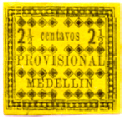

(Reduced sizes)

There are several types of these stamps.
2 1/2 c black on yellow 2 1/2 c red 5 c black on yellow 5 c red on yellow
Value of the stamps |
|||
vc = very common c = common * = not so common ** = uncommon |
*** = very uncommon R = rare RR = very rare RRR = extremely rare |
||
| Value | Unused | Used | Remarks |
| 2 1/2 c black on yellow | RR | RR | 2 types |
| 2 1/2 c red | R | R | 10 types |
| 5 c black on yellow | *** | *** | 6 types |
| 5 c red on yellow | *** | *** | 10 types |

2 1/2 c; may be a reprint.
20 c red 20 c green (1909) 40 c violet
Value of the stamps |
|||
vc = very common c = common * = not so common ** = uncommon |
*** = very uncommon R = rare RR = very rare RRR = extremely rare |
||
| Value | Unused | Used | Remarks |
| 20 c red | * | * | |
| 20 c green | * | * | |
| 40 c | * | * | |
20 c red (two types) 20 c orange (two types) 50 c lilac (two types) 1 P green
In Type I, the numbers are almost touching the word 'centavos'. In Type II, the numbers are quite far away from the word 'centavos'.
Value of the stamps |
|||
vc = very common c = common * = not so common ** = uncommon |
*** = very uncommon R = rare RR = very rare RRR = extremely rare |
||
| Value | Unused | Used | Remarks |
| 20 c | *** | *** | Two types, also exists in orange |
| 50 c | *** | *** | Two types |
| 1 P | R | R | |

1/4 c blue 1/2 c green 1 c lilac 1 c brown 2 c red 50 c orange 50 c green
Value of the stamps |
|||
vc = very common c = common * = not so common ** = uncommon |
*** = very uncommon R = rare RR = very rare RRR = extremely rare |
||
| Value | Unused | Used | Remarks |
| 1/4 c | c | * | |
| 1/2 c | * | * | |
| 1 c lilac | * | * | |
| 1 c brown | *** | *** | |
| 2 c | * | * | |
| 50 c orange | * | * | |
| 50 c green | * | * | |
50 c brown, red, violet and yellow 1 $ green, red, violet and yellow
Value of the stamps |
|||
vc = very common c = common * = not so common ** = uncommon |
*** = very uncommon R = rare RR = very rare RRR = extremely rare |
||
| Value | Unused | Used | Remarks |
| 50 c | * | * | |
| 1 $ | * | * | |
A 10 c stamp of Colombia was overprinted 'Habilitado Medellin AR' in 1903, see under Antioquia for more details:
5 c black on white or black on yellow 10 c black on white, grey or green
Value of the stamps |
|||
vc = very common c = common * = not so common ** = uncommon |
*** = very uncommon R = rare RR = very rare RRR = extremely rare |
||
| Value | Unused | Used | Remarks |
| 5 c | RRR | RR | |
| 10 c | RRR | RR | |
Reprints exist made in 1902 (*), if I'm well informed the sizes of these reprints are larger.
For stamps of Tolima click here.
$ 0.01 black $ 0.02 black $ 0.02 1/2 black $ 0.05 black $ 0.10 black $ 0.20 black $ 0.50 black $ 1.00 black $ 5.00 black
Value of the stamps |
|||
vc = very common c = common * = not so common ** = uncommon |
*** = very uncommon R = rare RR = very rare RRR = extremely rare |
||
| Value | Unused | Used | Remarks |
| 1 c | R | R | |
| 2 c | R | R | |
| 2 1/2 c | RR | RR | |
| 5 c | R | R | |
| 10 c | R | R | |
| 20 c | RR | RR | |
| 50 c | RR | RR | |
| 1 P | RRR | RRR | |
| 5 P | RRR | RRR | |
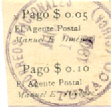
(0.05 c and 0.10 c printed together, reduced size)

Reduced size
5 c violet 10 c red
Value of the stamps |
|||
vc = very common c = common * = not so common ** = uncommon |
*** = very uncommon R = rare RR = very rare RRR = extremely rare |
||
| Value | Unused | Used | Remarks |
| 5 c | RRR | RRR | |
| 10 c | RRR | RRR | |

This cancel with the concentric circles seems to be typical of
Tumaco
1 c black 2 c black on blue
Also exists with larger 'H' in 'HAY'.
Value of the stamps |
|||
vc = very common c = common * = not so common ** = uncommon |
*** = very uncommon R = rare RR = very rare RRR = extremely rare |
||
| Value | Unused | Used | Remarks |
| 1 c | R | R | |
| 2 c | R | R | |

$ 0.01 black $ 0.02 black on lilac $ 0.05 black on blue
Value of the stamps |
|||
vc = very common c = common * = not so common ** = uncommon |
*** = very uncommon R = rare RR = very rare RRR = extremely rare |
||
| Value | Unused | Used | Remarks |
| 1 c | R | R | |
| 2 c | R | R | |
| 5 c | RR | RR | |
10 c black
Value of the stamps |
|||
vc = very common c = common * = not so common ** = uncommon |
*** = very uncommon R = rare RR = very rare RRR = extremely rare |
||
| Value | Unused | Used | Remarks |
| 10 c | RR | RR | |
1890 These stamps are bogus local stamps, eagle in an oval, they have the inscription 'REPUBLICA DE COLOMBIA ALMAGUER EL ADMOR'; 1 c black on blue, 5 c black on yellow. There also seems to exist a 2 c black on red value. Note that the two stamps have an elliptic cancel and on top of this a 'COLOMBIA' cancel in fancy letters forming almost a circle.
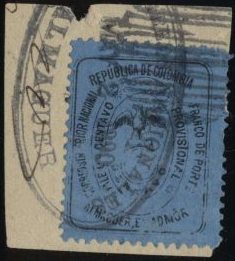
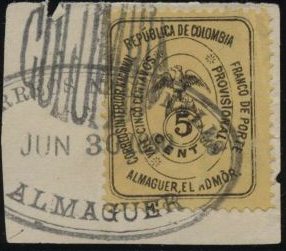
In the Philatelic Record of 1890 (page 173) one
can read:
Almaguer is not, as we imagined, the name of a State, but
that of a Postmaster, and a Philatelic Postmaster too. The stamps
bearing his name are declared to be frauds, and the only
consolation that we have is the news that their concocter is in
prison. We trust that this, at least, is true!
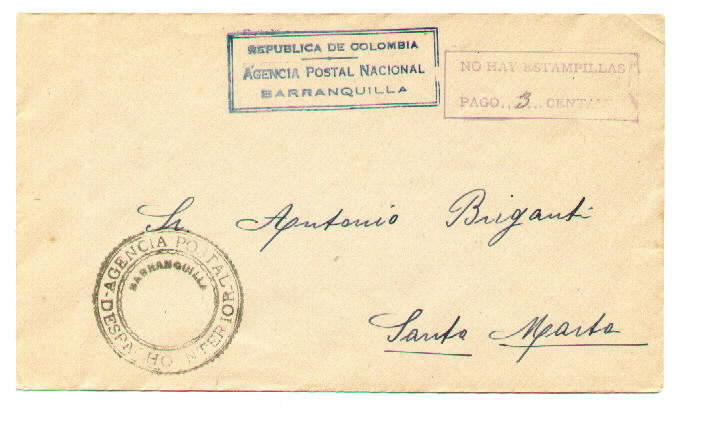
(Letter from Barrnaquilla, 'NO HAY ESTAMPILLAS PAGO 5 CENTAVOS'
cancel)